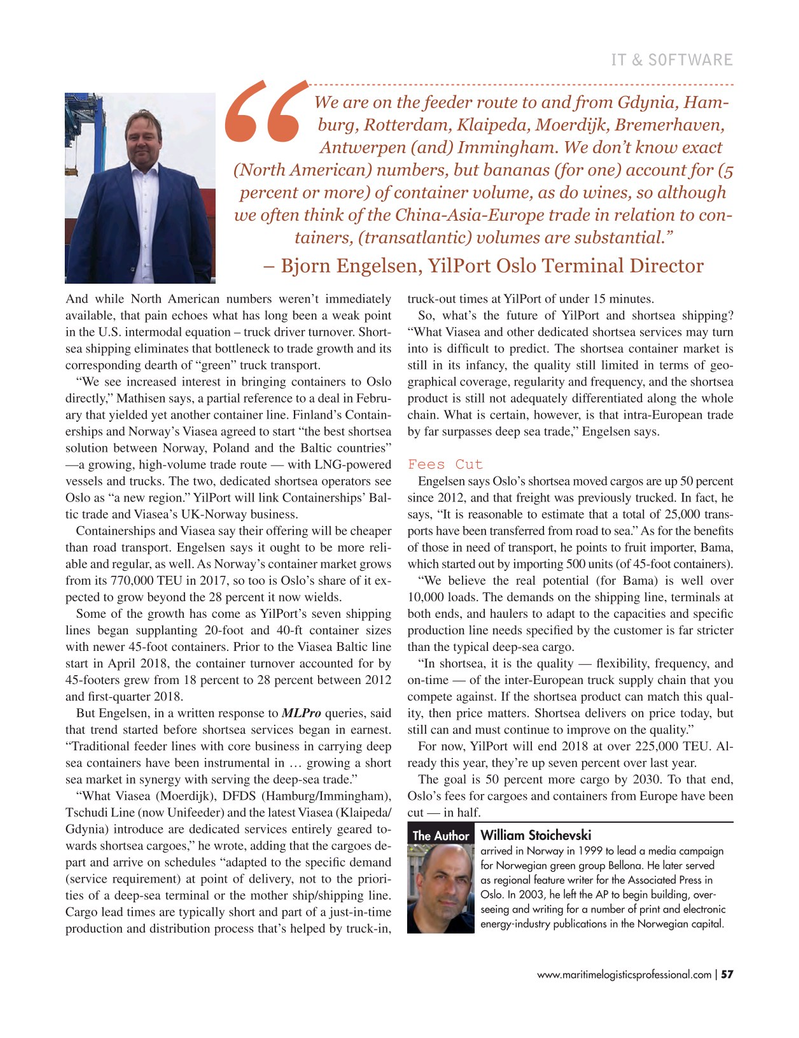
Page 57: of Maritime Logistics Professional Magazine (May/Jun 2018)
Container Ports
Read this page in Pdf, Flash or Html5 edition of May/Jun 2018 Maritime Logistics Professional Magazine
IT & SOFTWARE
We are on the feeder route to and from Gdynia, Ham- burg, Rotterdam, Klaipeda, Moerdijk, Bremerhaven,
Antwerpen (and) Immingham. We don’t know exact (North American) numbers, but bananas (for one) account for (5 percent or more) of container volume, as do wines, so although we often think of the China-Asia-Europe trade in relation to con- tainers, (transatlantic) volumes are substantial.” – Bjorn Engelsen, YilPort Oslo Terminal Director
And while North American numbers weren’t immediately truck-out times at YilPort of under 15 minutes.
available, that pain echoes what has long been a weak point So, what’s the future of YilPort and shortsea shipping? in the U.S. intermodal equation – truck driver turnover. Short- “What Viasea and other dedicated shortsea services may turn sea shipping eliminates that bottleneck to trade growth and its into is diffcult to predict. The shortsea container market is corresponding dearth of “green” truck transport. still in its infancy, the quality still limited in terms of geo- “We see increased interest in bringing containers to Oslo graphical coverage, regularity and frequency, and the shortsea directly,” Mathisen says, a partial reference to a deal in Febru- product is still not adequately differentiated along the whole ary that yielded yet another container line. Finland’s Contain- chain. What is certain, however, is that intra-European trade erships and Norway’s Viasea agreed to start “the best shortsea by far surpasses deep sea trade,” Engelsen says.
solution between Norway, Poland and the Baltic countries” —a growing, high-volume trade route — with LNG-powered Fees Cut vessels and trucks. The two, dedicated shortsea operators see Engelsen says Oslo’s shortsea moved cargos are up 50 percent
Oslo as “a new region.” YilPort will link Containerships’ Bal- since 2012, and that freight was previously trucked. In fact, he tic trade and Viasea’s UK-Norway business. says, “It is reasonable to estimate that a total of 25,000 trans-
Containerships and Viasea say their offering will be cheaper ports have been transferred from road to sea.” As for the benefts than road transport. Engelsen says it ought to be more reli- of those in need of transport, he points to fruit importer, Bama, able and regular, as well. As Norway’s container market grows which started out by importing 500 units (of 45-foot containers).
from its 770,000 TEU in 2017, so too is Oslo’s share of it ex- “We believe the real potential (for Bama) is well over pected to grow beyond the 28 percent it now wields. 10,000 loads. The demands on the shipping line, terminals at
Some of the growth has come as YilPort’s seven shipping both ends, and haulers to adapt to the capacities and specifc lines began supplanting 20-foot and 40-ft container sizes production line needs specifed by the customer is far stricter with newer 45-foot containers. Prior to the Viasea Baltic line than the typical deep-sea cargo. start in April 2018, the container turnover accounted for by “In shortsea, it is the quality — fexibility, frequency, and 45-footers grew from 18 percent to 28 percent between 2012 on-time — of the inter-European truck supply chain that you and frst-quarter 2018. compete against. If the shortsea product can match this qual-
But Engelsen, in a written response to MLPro queries, said ity, then price matters. Shortsea delivers on price today, but that trend started before shortsea services began in earnest. still can and must continue to improve on the quality.” “Traditional feeder lines with core business in carrying deep For now, YilPort will end 2018 at over 225,000 TEU. Al- sea containers have been instrumental in … growing a short ready this year, they’re up seven percent over last year. sea market in synergy with serving the deep-sea trade.” The goal is 50 percent more cargo by 2030. To that end, “What Viasea (Moerdijk), DFDS (Hamburg/Immingham), Oslo’s fees for cargoes and containers from Europe have been
Tschudi Line (now Unifeeder) and the latest Viasea (Klaipeda/ cut — in half.
Gdynia) introduce are dedicated services entirely geared to-
William Stoichevski
The Author wards shortsea cargoes,” he wrote, adding that the cargoes de- arrived in Norway in 1999 to lead a media campaign part and arrive on schedules “adapted to the specifc demand for Norwegian green group Bellona. He later served (service requirement) at point of delivery, not to the priori- as regional feature writer for the Associated Press in
Oslo. In 2003, he left the AP to begin building, over- ties of a deep-sea terminal or the mother ship/shipping line. seeing and writing for a number of print and electronic
Cargo lead times are typically short and part of a just-in-time energy-industry publications in the Norwegian capital.
production and distribution process that’s helped by truck-in, www.maritimelogisticsprofessional.com 57
I

 56
56

 58
58
